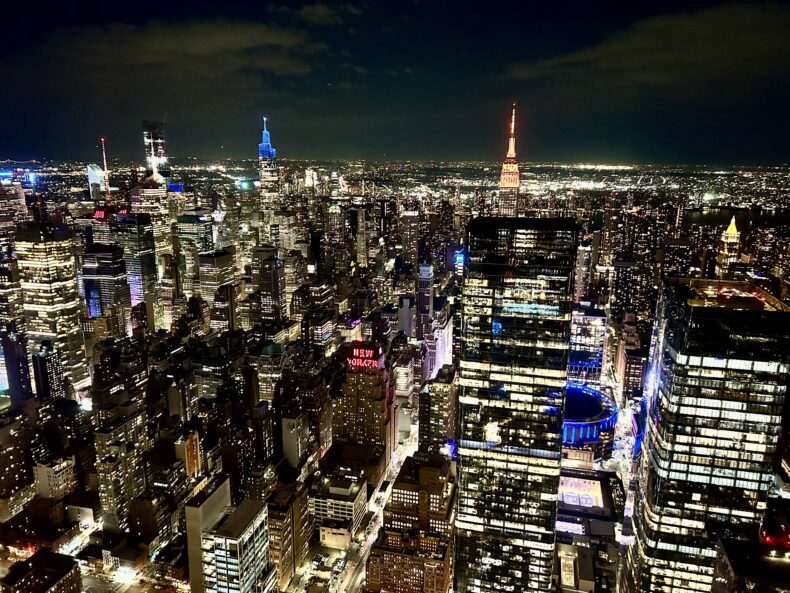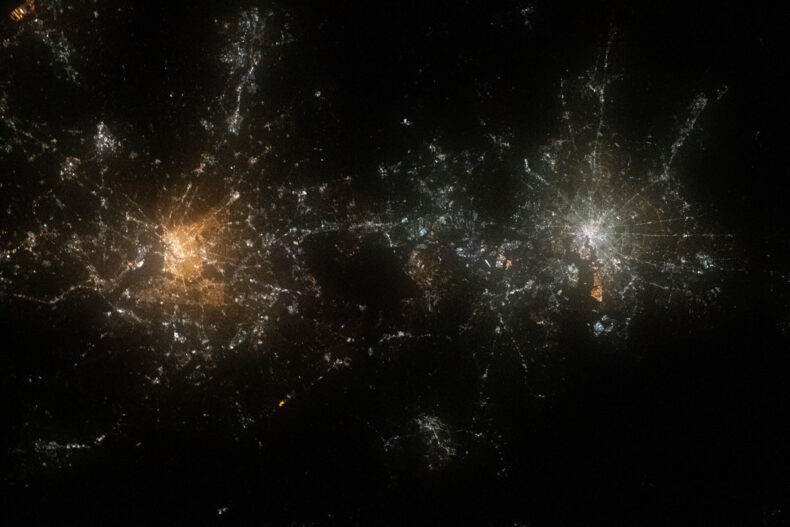
Last night I took a crowded elevator to the hundredth floor of a skyscraper in Manhattan. Not rattled or shaken, we were propelled to the top in 52 seconds, like being beamed up.
Doors opened and we all poured into a high-windowed space looking onto the electric-white boroughs of New York City. A revolving door turned us onto an outdoor viewing platform where hundreds gushed and posed at angled glass barriers tipped away from the building where one can lean over the edge more than a thousand feet above the ground. The Empire State Building with its colored spindle was not diminutive, but it didn’t reach our height, emerging like the tip of an awl from a crystalline sea. You can see it in the picture above, the spire in red.
The last time I was this high up in a piece of architecture was the late 90s in a bar on the 106th floor of the World Trade Center’s North Tower. I came with a friend on a winter night and I recall the elevator taking minutes, rocking as it went, opening partway where we had to get out and switch to another elevator to continue the ride. That was the technology of the time, the only way to be taken up this kind of swaying height. We handed coats to the woman at the coatroom and walked into the bar, which was aptly called Windows on the World.
The nocturnal city at the end of the 20th century raged around us, more light coming from outside than from the soft bar fixtures. We got our drinks and walked together out of the dark pit, climbing up a few short steps to the main floor and its museum of windows. You could tell tourists from the bar crawlers. Tourists, like us, bought drinks because we had to, and walked to the windows with glasses in hand, not taking a sip, staring 106 floors straight down. The view went down to the tips of our shoes, no visual buffer where windows met the tight-weave carpet, and it felt like you were stepping off the edge. This was a peculiar sensation considering what happened a few years later when Windows on the World, fully staffed, crashed to the ground and all were lost. Our mouths opened slightly as if not believing what we were seeing, as if the bar crawlers had gone blind talking and laughing as if they weren’t suspended in the sky. Their voices drained away as we looked down on this transparent glass fish of a city, every tiny bone wired and glowing.
It was a different kind of light back then, softer, more oranges and yellows. I can’t remember the difference exactly, but last night I saw a much brighter city pegging the blue-white end of the spectrum. This comes from the recent and ongoing revolution of light emitting diodes, the rise of the LED. Now the city meets the eye like an infinity of needles. In 2001 LEDs worldwide constituted 1 percent of all lights being sold, rising to 47 percent in 2019, then 66 percent in 2020. They came on the market as an environmental savior, cheaper and more efficient than the old gas discharge variety, promoted as a thing we could do to save the planet. It’s hard to find bad press on them. But the expected drop in energy use didn’t pan out. Instead, it increased. The lights are so cheap to buy and operate we’ve employed them to the point of overflowing. Over twelve years between 1992 and 2013, Air Force satellites picked up a 40 percent increase in artificial light worldwide, and some regions spiked by 400 percent.
The night sky has paid a price. Sightings from 51,351 citizen scientists worldwide were gathered between 2011 and 2022 showing an alarming decrease in how much night sky is visible. Each participant in the study, mostly from industrialized regions, was given a set of star maps and asked which best matches the view at their location. On average, if 250 stars were visible at the start of the study in 2011, 100 could be seen by the end, 18 years later. Almost 10 percent of skies are vanishing from our collective view every year, with LEDs leading the way.
As recently as 2020, Washington DC had not gone fully LED, while neighboring Baltimore already made the switch. From space, the two cities side by side had the appearance of an off-eyed dog, DC a honey color, Baltimore a magnesium fire. Here’s the picture from four years ago, DC on the left, Baltimore on the right:

The slogan for DC’s campaign to switch over to LEDs is “Better Brighter,” and now the city has joined the blue-white parade. This makes a crisper, more defined and less diffuse light across the city. A friend who lives in a DC neighborhood told me that when streetlights around his house were upgraded to LEDs, he had to start closing curtains and blinds.
From the top of New York last night, I can’t say I was horrified by what I saw. It was more a sense of awe, my eyes lost in a fluorescing maze. I do remember the lights being softer decades ago, easier on the eye. Now, I felt even more that I was up on my toes, nerves brought to attention. Ignoring the macular degeneration that comes from LEDs and the crash of circadian rhythms in our bodies, I felt like a cheerleader for civilization, taking pictures and waving my pom-poms as high as I could get them.
Top photo: CC
Thank you for this new information and perspective on LEDs. We’ve gradually replaces our house lights with LEDs too, but usually the ones that have adopted the more yellow spectrum. I hate that harsh blue-white light. It’s like the flourescents used in Israeli homes along with the turquoise wall paint. Ghastly vision! Anyway, now my complaint aims sharply at those blinding car headlights. Why haven’t they been banned? How many nighttime crashes has occurred because of those? Meanwhile, between the LEDs lamps and spending far too much screen time, we’re going blind. This article has helped me understand the combination.
Hi Craig,
Thanks for this essay! Last week, I witnessed a total solar eclipse where I live close to the border of Canada, not far from the Adirondacks. While I watched it with a number of families and couples on a farm outside of town, many of the students at the college where I work experienced “Total Eclipse of the Quad,” a raucous party of an encounter with the change in light.
And so, the moment you speak of people standing on the top of a skyscraper, possibly overwhelmed viewers of so much brightness, reminds me of all those students gathered together in one place. I imagine the energy, the racket, all the selfies, and an unexpected view that in my students’ case could blind if they did not heed the astronomer’s instructions amplified by a bullhorn.
The next day, I gave my students a section of a poem by Adrienne Rich in order to help them make sense of the commotion of people witnessing the cosmos. It is from her long sequence of poems in “An Atlas of the Difficult World” (written in 1990-1991).
“VII: (The Dream-Site)” begins in a rooftop in New York City, the speaker leaning back to take in:
“the nightvault swarming with stars
the Pleiades broken loose, not seven but thousands
every known constellation flinging out fiery threads”
She speaks of a space with stars “coherently hammocked” and “blueblack avenues,” all that can be seen and known intimately even at this distance.
But then the speaker looks down to New York, “the city of dreadful light,” with its “sacks of garbage … [rising] like barricades.”
She only perks up when she thinks of :
“bodies young and ordinary riding the subways reading
or pressed against other bodies
feeling in them the maps of Brooklyn Queens Manhattan
The Bronx unscrolling in the long breakneck
express plunges
as darkly we felt our own blood
streaming a living city overhead
coherently webbed and knotted bristling
we and all the others
known and unknown
living its life”
Since you’ve given me a new view of cities as seen from great heights, I wanted to remind you of Adrienne Rich’s pre-LED view.